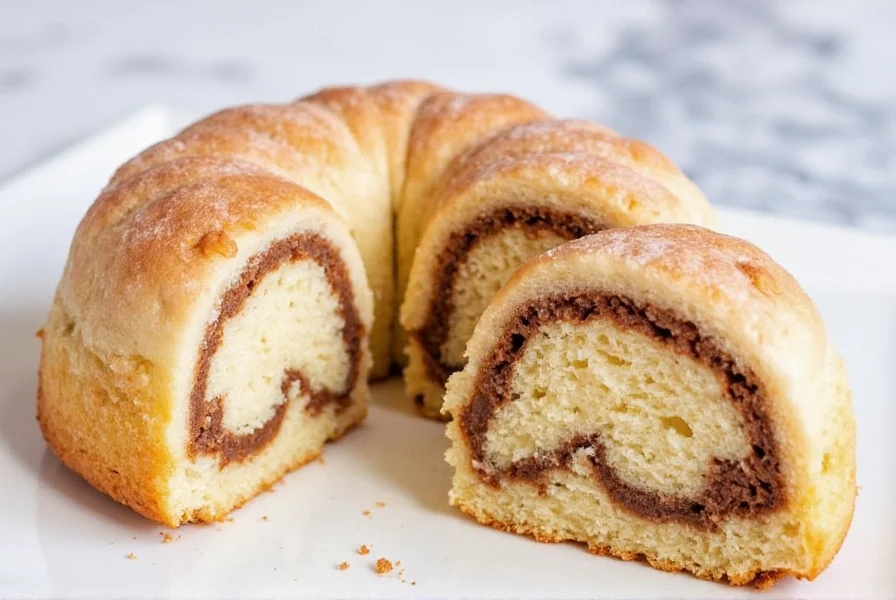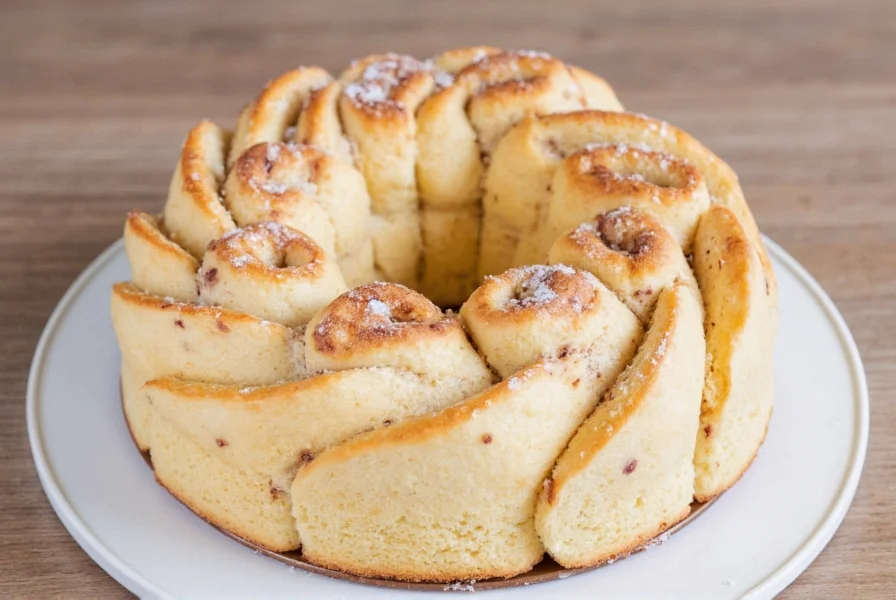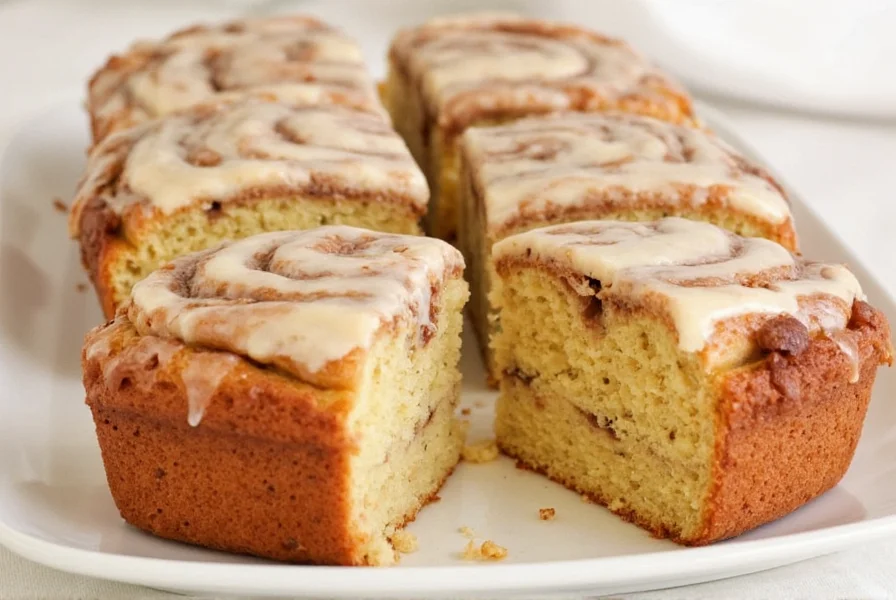The cinnamon roll cake is a delicious hybrid dessert combining the swirls and flavors of traditional cinnamon rolls with the structure of a cake. This single-layer cake features a moist vanilla base swirled with cinnamon-sugar filling, topped with cream cheese frosting. Most recipes require approximately 1 hour of total preparation and baking time at 350°F (175°C), serving 8-12 people.
If you've ever wished you could enjoy the comforting swirls of cinnamon rolls without the tedious rolling process, the cinnamon roll cake delivers that same nostalgic flavor in a simpler format. This popular dessert has gained traction among home bakers seeking to recreate the beloved bakery treat with less effort while maintaining that signature cinnamon swirl experience.
What Makes Cinnamon Roll Cake Special
Unlike traditional cinnamon rolls that require rolling and cutting individual portions, the cinnamon roll cake bakes as a single layer in a 9x13 inch pan. The magic happens when you pour the cake batter into the pan, sprinkle the cinnamon-sugar mixture over it, then use a knife to create swirls throughout the batter before baking. This technique creates those distinctive marbled patterns reminiscent of classic cinnamon rolls.

Essential Ingredients for Perfect Cinnamon Roll Cake
The beauty of this dessert lies in its simplicity. You'll need standard baking pantry staples with a few specialty ingredients that create that authentic cinnamon roll flavor profile:
| Category | Ingredients | Key Purpose |
|---|---|---|
| Cake Base | All-purpose flour, baking powder, salt, unsalted butter, sugar, eggs, vanilla extract, milk | Creates the light, tender cake structure |
| Cinnamon Filling | Brown sugar, granulated sugar, ground cinnamon, melted butter | Provides the signature swirl and flavor |
| Frosting | Cream cheese, butter, powdered sugar, vanilla extract, salt | Delivers that essential tangy-sweet finish |
Step-by-Step Baking Instructions
Follow these detailed steps for cinnamon roll cake success every time:
- Prepare your pan: Grease a 9x13 inch baking dish and line with parchment paper for easy removal
- Mix dry ingredients: Whisk together 2 cups flour, 1½ tsp baking powder, and ¼ tsp salt in medium bowl
- Cream butter and sugar: Beat ½ cup softened butter with 1 cup sugar until light and fluffy (about 3 minutes)
- Add wet ingredients: Beat in 2 eggs one at a time, then 2 tsp vanilla extract
- Combine: Alternately add dry ingredients and ½ cup milk, beginning and ending with dry ingredients
- Create filling: Mix ½ cup melted butter with 1 cup brown sugar, 2 tbsp granulated sugar, and 2 tbsp cinnamon
- Assemble: Pour cake batter into prepared pan, then drizzle cinnamon mixture evenly over top
- Swirl: Use a knife to create figure-eight patterns through the batter (don't overmix)
- Bake: 30-35 minutes at 350°F (175°C) until toothpick inserted comes out clean
- Frost: Cool completely, then spread cream cheese frosting over top
Pro Tips for Cinnamon Roll Cake Success
Even experienced bakers encounter challenges with this hybrid dessert. These professional tips ensure perfect results:
- Don't over-swirl: Creating too many swirls can incorporate the cinnamon mixture too thoroughly, losing that distinctive marbled appearance
- Cool completely: Applying frosting to warm cake causes it to melt and slide off - wait at least 2 hours
- Room temperature ingredients: Cold eggs or butter create an uneven batter that affects texture
- Measure flour correctly: Spoon flour into measuring cup then level - don't scoop directly from bag (prevents dense cake)
- Filling consistency: The cinnamon mixture should be pourable but not watery - adjust melted butter as needed

Popular Variations to Try
Once you've mastered the basic cinnamon roll cake recipe, experiment with these creative adaptations:
- Nutty version: Add ½ cup chopped pecans or walnuts to the cinnamon filling for texture
- Apple cinnamon: Layer 1 cup finely diced apples between the batter and cinnamon mixture
- Cheesecake swirl: Drop spoonfuls of cheesecake batter throughout before swirling
- Gluten-free: Substitute 1:1 gluten-free flour blend and ensure other ingredients are GF certified
- Mini cake version: Bake in 8x8 pan for 25-30 minutes for a smaller batch
Storage and Serving Recommendations
Proper storage maintains the cake's texture and flavor:
- Room temperature: Store covered for up to 2 days (frosting may soften)
- Refrigeration: Keep in airtight container for 5-7 days (best for cream cheese frosted versions)
- Freezing: Wrap unfrosted cake tightly and freeze up to 3 months; thaw before frosting
- Serving: Bring to room temperature before serving for optimal flavor and texture
- Pairings: Complements well with coffee, vanilla ice cream, or a dollop of whipped cream
Troubleshooting Common Issues
Address these frequent cinnamon roll cake problems with these solutions:
- Dry cake: Overbaking or too much flour - check at 28 minutes and measure flour properly
- Sunken middle: Opening oven door too early or underbaked - avoid checking before 25 minutes
- Filling sinking: Batter too thin or filling too liquid - ensure proper batter consistency
- Sticky frosting: Too much milk or warm cake - use less liquid and ensure cake is completely cool
- Dull flavor: Old spices or insufficient cinnamon - use fresh spices and don't skimp on cinnamon
Frequently Asked Questions
Can I make cinnamon roll cake ahead of time?
Yes, you can prepare cinnamon roll cake up to two days in advance. Bake and cool completely, then store unfrosted in an airtight container at room temperature. Add the cream cheese frosting no more than 4 hours before serving for best texture and appearance. For longer storage, freeze the unfrosted cake for up to three months, then thaw and frost before serving.
Why did my cinnamon filling sink to the bottom?
Cinnamon filling sinks when the cake batter is too thin or the filling mixture contains too much liquid. To prevent this, ensure your cake batter has a thick, spoonable consistency (not runny), and use the proper ratio of ½ cup melted butter to 1½ cups sugar mixture. Chilling the assembled cake for 15 minutes before baking can also help the filling set in place.
How do I prevent my cinnamon roll cake from becoming dry?
To maintain moisture in your cinnamon roll cake, don't overbake (check at 28 minutes), measure flour correctly by spooning it into measuring cups, and don't overmix the batter. Using buttermilk instead of regular milk adds moisture, as does including an extra egg yolk. Proper storage in an airtight container also prevents drying out.
Can I use a boxed cake mix for cinnamon roll cake?
Yes, you can adapt a vanilla or yellow cake mix for cinnamon roll cake. Prepare the mix according to package directions, then layer it with your cinnamon-sugar mixture as described in the recipe. The texture may differ slightly from scratch baking, but it creates a convenient shortcut. Many bakers find adding an extra egg and ½ tsp vanilla enhances the homemade flavor when using box mixes.
What's the difference between cinnamon roll cake and regular cinnamon rolls?
Cinnamon roll cake bakes as a single layer in a rectangular pan with the cinnamon filling swirled throughout, while traditional cinnamon rolls are individually portioned after rolling the dough. The cake version requires less hands-on time (no rolling and cutting), bakes faster, and serves more people from one pan. Both share the same flavor profile but differ in texture and preparation method.











 浙公网安备
33010002000092号
浙公网安备
33010002000092号 浙B2-20120091-4
浙B2-20120091-4